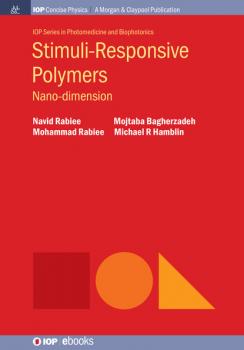ТОП просматриваемых книг сайта:
Michael R Hamblin
Список книг автора Michael R HamblinАннотация
This book provides a general introduction to nanogels, and designs of various stimuli-sensitive nanogels that are able to control drug release in response to specific stimuli. Nanogels are three-dimensional nanosized networks that formed by physically or chemically crosslinking polymers. They have highly interesting properties such as biocompatibility, high stability, particle size adjustment, drug loading capability and modification of the surface for active targeting. They can respond to stimuli which results in the controlled release of drug and targeting of the site.
Аннотация
Nanomedicine is a developing field, which includes different disciplines such as material science, chemistry, engineering and medicine devoted to the design, synthesis and construction of high-tech nanostructures. The ability of these structures to have their chemical and physical properties tuned by structural modification, has allowed their use in drug delivery systems, gene therapy delivery, and various types of theranostic approaches. Colloidal noble metal nanoparticles and other nanostructures have many therapeutic and diagnostic applications. The concept of drug targeting as a magic bullet has led to much research in chemical modification to design and optimize the binding to targeted receptors. It is important to understand the precise relationship between the drug and the carrier and its ability to target specific tissues, and pathogens to make an efficient drug delivery system. This book covers advances based on different drug delivery systems: polymeric and hyper branched nanomaterials, carbon-based nanomaterials, nature-inspired nanomaterials, and pathogen-based carriers.
Аннотация
Janus, the ancient Roman god depicted with two faces is an appropriate metaphor for light therapy. In the right photodynamic therapy conditions, light is able to kill nearly anything that is living such as cancers, microorganisms, parasites, and more. On the opposite face, light of the correct wavelength and proper dose (photobiomodulation) can heal, regenerate, protect, revitalize and restore any kind of dead, damaged, stressed, dying, degenerating cells, tissue, or organ system. This book discusses both sides of Janus' face in regards to light therapy.
Antimocrobial Photodynamic Inactivation and Antitumor Photodynamic Therapy with Fullerenes - Michael R Hamblin
IOP Concise PhysicsАннотация
This book provides detailed and current information on using fullerenes (bucky-balls) in photodynamic therapy (PDT), one of the most actively studied applications of photonic science in healthcare. This will serve as a useful source for researchers working in photomedicine and nanomedicine, especially those who are investigating PDT for cancer treatment and infectious disease treatment. The book runs the gamut from an introduction to the history and chemistry of fullerenes and some basic photochemistry, to the application of fullerenes as photosensitizers for cancer and antimicrobial inactivation.
Smart Internal Stimulus-Responsive Nanocarriers for Drug and Gene Delivery - Michael R Hamblin
IOP Concise PhysicsАннотация
The concept of smart drug delivery vehicles involves designing and preparing a nanostructure (or microstructure) that can be loaded with a cargo. This can be a therapeutic drug, a contrast agent for imaging, or a nucleic acid for gene therapy. The nanocarrier serves to protect the cargo from degradation by enzymes in the body, to enhance the solubility of insoluble drugs, to extend the circulation half-life, and to enhance its penetration and accumulation at the target site. Importantly, smart nanocarriers can be designed to be responsive to a specific stimulus, so that the cargo is only released or activated when desired. In this volume we cover smart nanocarriers that respond to internal stimuli that are intrinsic to the target site. These stimuli are specific to the cell type, tissue or organ type, or to the disease state (cancer, infection, inflammation etc). pH-responsive nanostructures can be used for cargo release in acidic endosomal compartments, in the lower pH of tumors, and for specific oral delivery either to the stomach or intestine. Nanocarriers can be designed to be substrates of a wide-range of enzymes that are over-expressed at disease sites. Oxidation and reduction reactions can be taken advantage of in smart nanocarriers by judicious molecular design. Likewise, nanocarriers can be designed to respond to a range of specific biomolecules that may occur at the target site. In this volume we also cover dual and multi-responsive systems that combine stimuli that could be either internal or external.
Информация о книге
Автор произведения Michael R Hamblin
Жанр Отраслевые издания
Серия IOP Concise Physics
Smart External Stimulus-Responsive Nanocarriers for Drug and Gene Delivery - Michael R Hamblin
IOP Concise PhysicsАннотация
The concept of smart drug delivery vehicles involves designing and preparing a nanostructure (or microstructure) that can be loaded with a cargo, this can be a therapeutic drug, a contrast agent for imaging, or a nucleic acid for gene therapy. The nanocarrier serves to protect the cargo from degradation by enzymes in the body, to enhance the solubility of insoluble drugs, to extend the circulation half-life, and to enhance its penetration and accumulation at the target site. Importantly, smart nanocarriers can be designed to be responsive to a specific stimulus, so that the cargo is only released or activated when desired. In this volume we cover smart nanocarriers that respond to externally applied stimuli that usually involve application of physical energy. This physical energy can be applied from outside the body and can either cause cargo release, or can activate the nanostructure to be cytotoxic, or both. The stimuli covered include light of various wavelengths (ultraviolet, visible or infrared), temperature (increased or decreased), magnetic fields (used to externally manipulate nanostructures and to activate them), ultrasound, and electrical and mechanical forces. Finally we discuss the issue of nanotoxicology and the future scope of the field.
Информация о книге
Автор произведения Michael R Hamblin
Жанр Отраслевые издания
Серия IOP Concise Physics






